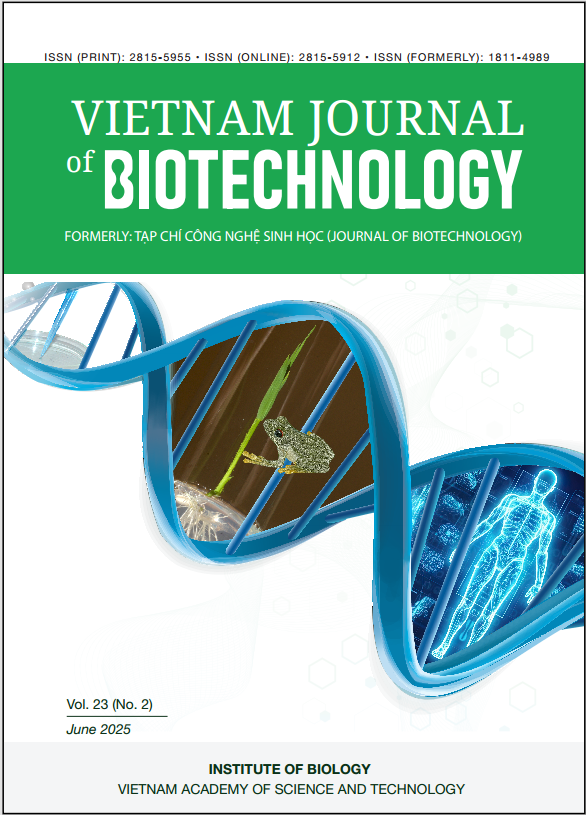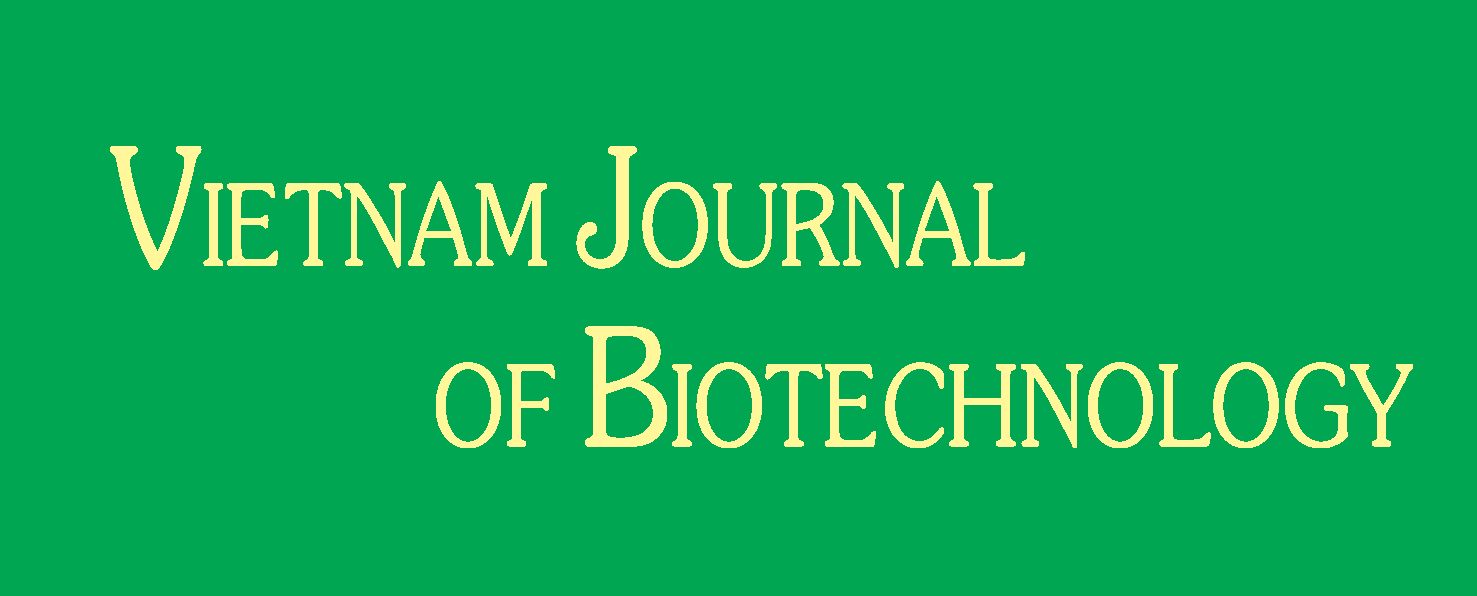Evaluation of antimutagenic, antiangiogenic, and cytotoxicity against cancerous cells of mycelial extract of Cordyceps militaris
Author affiliations
DOI:
https://doi.org/10.15625/vjbt-22132Keywords:
Cordyceps militaris, anticancer, antimutagenic, antiangiogenic, cytotoxicity, methanolic mycelial extract, MDA-MB-231Abstract
The high incidence and mortality rates of cancer necessitate the continuous search for effective anticancer therapies. Although synthetic drugs have been instrumental in modern medicine, their side effects drive the exploration of new, less harmful alternatives. Natural compounds are particularly favoured for their specificity, minimal side effects, and cost-effectiveness. In this study, the methanolic mycelial extract of Cordyceps militaris was evaluated for its antimutagenic, antiangiogenic, and cytotoxic properties. Antimutagenic activity assessed using the AMES test revealed a significant, concentration-dependent reduction in mutagenicity induced by sodium azide, benzo[a]pyrene, and 4-nitroquinoline-N-oxide in Salmonella tester strains TA98, TA100, and TA102, with up to 68.4% inhibition. Antiangiogenic effects, examined via the chorioallantoic membrane (CAM) assay, demonstrated substantial concentration-dependent inhibition of angiogenesis, achieving up to 88.4% inhibition at 100 µg/ml. The extract effectively suppressed the formation of angiogenic branch points, suggesting a potential role in inhibiting tumor neovascularization. Cytotoxic effects on the MDA-MB-231 breast cancer cell line, assessed through MTT assay, indicated a marked reduction in cell viability, with an IC₅₀ value of 54.86 µg/ml, while no significant cytotoxicity was observed in normal Vero cells. Morphological observations of treated cancer cells showed distinct cytoplasmic condensation, cell shrinkage, and detachment, indicative of apoptotic cell death. These findings highlight the multifaceted anticancer potential of C. militaris mycelial extract. This study underscores the therapeutic potential of C. militaris as a natural source of anticancer agents and provides a scientific foundation for further preclinical and clinical exploration.
Downloads
References
Bray, F., Ferlay, J., Soerjomataram, I., Siegel, R. L., Torre, L. A., & Jemal, A. (2018). Global cancer statistics 2018: GLOBOCAN estimates of incidence and mortality worldwide for 36 cancers in 185 countries. CA: A Cancer Journal for Clinicians, 68(6), 394–424. http://doi.org/10.3322/caac.21492
Brewer, M. S. (2011). Natural antioxidants: Sources, compounds, mechanisms of action, and potential applications. Comprehensive Reviews in Food Science and Food Safety, 10(4), 221–247. http://doi.org/10.1111/j.1541-4337.2011.0 0156.x
Carmeliet, P., & Jain, R. K. (2011). Principles and mechanisms of vessel normalization for cancer and other angiogenic diseases. Nature Reviews Drug Discovery, 10(6), 417–427. http:// doi.org/10.1038/nrd3455
De Flora S. (1979). Metabolic activation and deactivation of mutagens and carcinogens. The Italian Journal of Biochemistry, 28(2), 81–103.
De Sousa E Melo, F., Vermeulen, L., Fessler, E., & Medema, J. P. (2013). Cancer heterogeneity-a multifaceted view. EMBO reports, 14(8), 686–695. http://doi.org/10.1038/embor.2013.92
Deshmukh, N., & Lakshmi, B. (2023). Antioxidant potential of cordyceps militaris mycelium: a comparative analysis of methanol and aqueous extracts. Biosciences Biotechnology Research Asia, 20(4), 1487–1499.
Dong, C., Guo, S., Wang, W., & Liu, X. (2015). Cordyceps industry in China. Mycology, 6(2), 121–129. http://doi.org/10.1080/21501203.2015 .1043967
Freese, E. (1971). Molecular mechanisms of mutations. In: Hollaender, A. (eds) Chemical Mutagens. Springer, Boston, MA. http://doi.org/10.1007/978-1-4615-8966-2_1
Fuertes, M. A., Castilla, J., Alonso, C., & Pérez, J. M. (2003). Cisplatin biochemical mechanism of action: from cytotoxicity to induction of cell death through interconnections between apoptotic and necrotic pathways. Current medicinal chemistry, 10(3), 257–266. http://doi.org/10.2174/0929867033368484
Harrington, K. J. (2011). Biology of cancer. Medicine, 39(12), 689–692. http://doi.org/10.1016/j.mpmed.2011.09.015
Jeong, J. W., Jin, C. Y., Park, C., Hong, S. H., Kim, G. Y., Jeong, Y. K., et al. (2011). Induction of apoptosis by cordycepin via reactive oxygen species generation in human leukemia cells. Toxicology in Vitro, 25(4), 817–824. http://doi.org/10.1016/j.tiv.2011.02.001
Kasai, H. (2016). What causes human cancer? Approaches from the chemistry of DNA damage. Genes and Environment, 38(1), 19. http://doi.org/10.1186/s41021-016-0046-8
Li, S. P., Zhao, K. J., Ji, Z. N., Song, Z. H., Dong, T. T., Lo, C. K., et al. (2003). A polysaccharide isolated from Cordyceps sinensis, a traditional Chinese medicine, protects PC12 cells against hydrogen peroxide-induced injury. Life Sciences, 73(19), 2503–2513. http://doi.org/10.1016/s0024-3205(03)00652-0
Maron, D. M., & Ames, B. N. (1983). Revised methods for the Salmonella mutagenicity test. Mutation Research/Environmental Mutagenesis and Related Subjects, 113(3), 173–215. http://doi.org/10.1016/0165-1161(83)90010-9
Nakamura, K., Shinozuka, K., & Yoshikawa, N. (2015). Anticancer and antimetastatic effects of cordycepin, an active component of Cordyceps sinensis. Journal of Pharmacological Sciences, 127(1), 53–56. http://doi.org/10.1016/j.jphs.2014.09.001
Panda, A. K., & Swain, K. C. (2011). Traditional uses and medicinal potential of Cordyceps sinensis of Sikkim. Journal of Ayurveda and Integrative Medicine, 2(1), 9–13. http://doi.org/10.4103/0975-9476.78183
Rajabi, M., & Mousa, S. A. (2017). The role of angiogenesis in cancer treatment. Biomedicines, 5(2), 34. http://doi.org/10.3390/biomedicines 5020034
Reis, F. S., Barros, L., Calhelha, R. C., Ćirić, A., van Griensven, L. J. L. D., Soković, M., et al. (2013). The methanolic extract of Cordyceps militaris (L.) Link fruiting body shows antioxidant, antibacterial, antifungal and antihuman tumor cell lines properties. Food and Chemical Toxicology, 62, 91–98. http://doi.org/10.1016/j.fct.2013.08.033
Ribatti, D., Tamma, R., & Annese, T. (2021). Chorioallantoic membrane vascularization. A meta-analysis. Experimental Cell Research, 405(2), 112716. http://doi.org/10.1016/j.yexcr.2021.112716
Shih, I. L., Tsai, K. L., & Hsieh, C. (2007). Effects of culture conditions on the mycelial growth and bioactive metabolite production in submerged culture of Cordyceps militaris. Biochemical Engineering Journal, 33(3), 193–201. http://doi.org/10.1016/j.bej.2006.10.019
Słoczyńska, K., Powroźnik, B., Pękala, E., & Waszkielewicz, A. M. (2014). Antimutagenic compounds and their possible mechanisms of action. Journal of Applied Genetics, 55(2), 273–285. http://doi.org/10.1007/s13353-014-0198-9
Tongmai, T., Maketon, M., & Chumnanpuen, P. (2018). Prevention potential of Cordyceps militaris aqueous extract against cyclophosphamind-induced mutagenicity and sperm abnormality in rats. Agriculture and Natural Resources, 52(5), 419–423. http://doi.org/10.1016/j.anres.2018.11.005
Tuli, H. S., Sandhu, S. S., Kashyap, D., & Sharma, A. K. (2014). Optimization of extraction conditions and antimicrobial potential of a bioactive metabolite, cordycepin from Cordyceps militaris 3936. World Journal of Pharmaceutical Sciences, 3, 1525-1535.
van Meerloo, J., Kaspers, G. J., & Cloos, J. (2011). Cell sensitivity assays: the MTT assay. Methods in Molecular Biology (Clifton, N.J.), 731, 237–245. http://doi.org/10.1007/978-1-61779-080-5_20
Vasudev, N. S., & Reynolds, A. R. (2014). Anti-angiogenic therapy for cancer: current progress, unresolved questions and future directions. Angiogenesis, 17(3), 471–494. http://doi.org/10.1007/s10456-014-9420-y
Xie, H., Li, X., Chen, Y., Lang, M., Shen, Z., & Shi, L. (2019). Ethanolic extract of Cordyceps cicadae exerts antitumor effect on human gastric cancer SGC-7901 cells by inducing apoptosis, cell cycle arrest and endoplasmic reticulum stress. Journal of Ethnopharmacology, 231, 230–240. http://doi.org/10.1016/j.jep.2018.11.028
Zirlik, K., & Duyster, J. (2018). Anti-angiogenics: current situation and future perspectives. Oncology Research and Treatment, 41(4), 166–171. http://doi.org/10.1159/000488087







